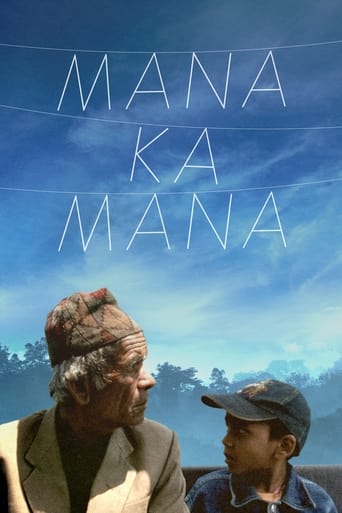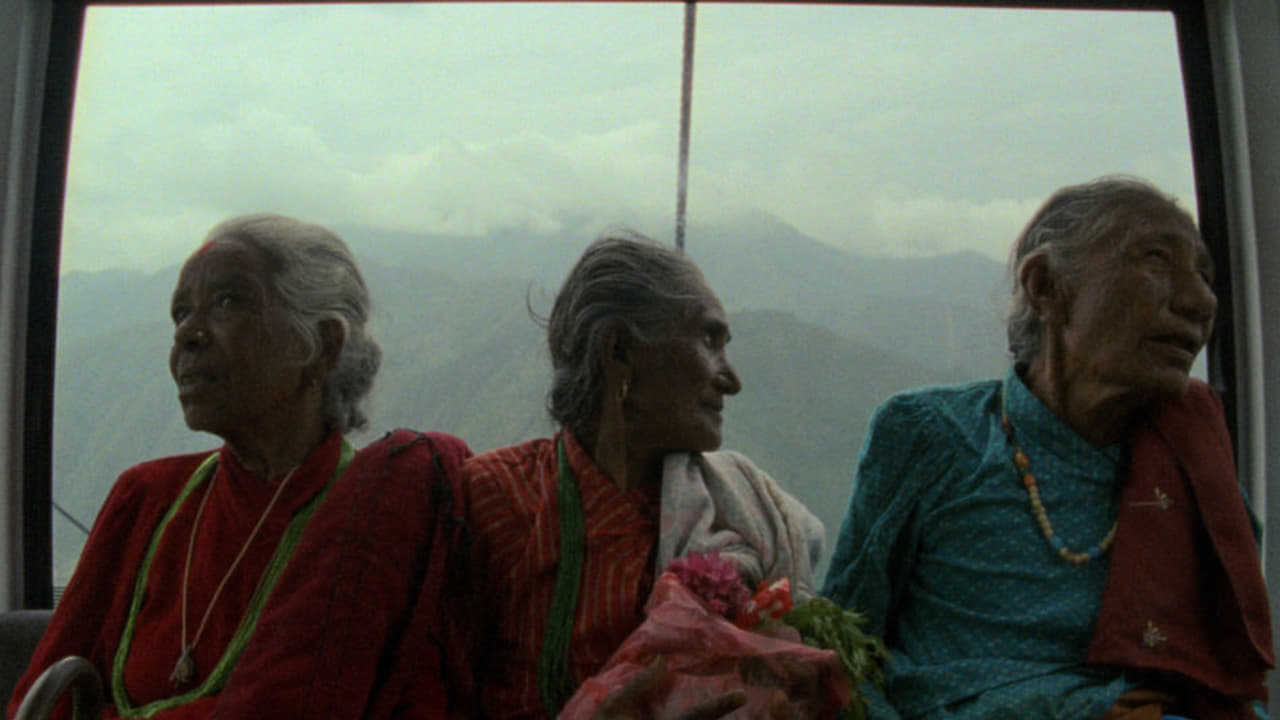Gareth Crook
It starts slow, really painfully slow. No dialogue until 25 minutes, when a couple get in and mention they're going to worship at the temple and what fun it'll be. They have a chicken with them. We see the couple again at the end, the only people to appear twice. They still have the chicken, but it's feet are sticking out of a carrier bag. It's an odd documentary, like zen people watching. The idea being you're in the cable car with them, climbing up and down the Nepalese hillsides. It's made to look like one continuous shot, but isn't, although there's still a real honesty and clarity about it. Each time the car reaches a station, it plunges into darkness at the turnaround, there's a wait to see who's next as figures slowly reveal themselves in the shadows. Then with a sudden rush of sunlight as the car emerges, we're greeted with goats! Fantastic!! The goats watch as the hill side passes. What do they make of it is anyone's guess, but a few euphoric sounding bleats suggest they're having fun. At least until they get to the temple that is. The three metalheads taking photos are very funny and the two old ladies struggling with fast melting ice-cream are hilarious!! There's a weird intermission of darkness at the half way mark, with a few minutes of just sound. It's eerie, but fits well. As unusually entertaining as all this is, it's the two guys that get in with their instruments (Sarangi... I googled it) that steal the show. They muse on how things have changed in the world, tune up said instruments and proceed to bang out a song. It could be that much of the silence in the film heightens this musical interlude, but it's still pretty cool. Which is a good summary of the film, it's pretty cool.
Howard Schumann
If life is up and down with a few bumps along the way, what better representation is there than a cable car's ride up and down a mountain? This particular cable car ride takes place in the riveting documentary Manakamana, a ride that brings passengers, both foreign and local, to the Manakamana Temple in the Gorkha district of Nepal. Consisting of ten-minute segments with extra time taken to show a darkened terminus building, the film is a portrait of nine different families and friends visiting a shrine to the Hindu goddess Manakamana who, it is believed, makes wishes come true.Stephanie Spray and Pacho Velez (Leviathan) of Harvard's Sensory Ethnography Lab, with their 16mm camera anchored to the floor, simply filmed people going up to the 17th century temple, as well as those on their way down (one trip is a voyage with four goats tied together being brought to the temple to be sacrificed). Out of thirty-five trips shot by the filmmakers, eleven were selected and the film was edited over a period of eighteen months. Spray, who has lived in Nepal since 1999 knew some of the passengers and this may account for the fact that conversations are natural and relaxed, even though I'm sure they couldn't help being aware of the camera.The first trip is silent as an elderly man sits next to his grandson, occasionally gazing at the passing scenery as the car climbs higher and higher. When conversations do begin after about twenty minutes into the film, people talk about their families, their religion, the way it used to be, a trail that is no longer used, and the replacement of thatched roofs by slate and slate roofs by tin. Many comment on the beauty of the surrounding hills and the sal trees, said to be favored by Vishnu in the Hindu tradition and under which Buddha is supposed to have been born.Three older women chant their message of worship to the goddess while, in a sharp cultural shift, three long-haired young men talk about their rock band and take pictures of themselves from their mobile device. Additionally, there are two young women who speak English, one sounding like an American, the other Nepalese. We are also entranced by the journey of two accomplished musicians who perform on the traditional stringed instrument known as the sarangi. One of the most entertaining and playful sequences is that of two older women on their way down eating ice cream on a stick, trying to prevent it from dripping all over them and the cable car.Many of the passengers bring offerings to the goddess such as a basket of flowers and a rooster, though it is reported that the sacrifice of poultry has been banned. While it is tempting to search for a spiritual message from the film, to me its pleasure lies in the simple joy of just being with a diverse group of people, some young, some old, and sharing some time with them. The American girl tells her friend that she has had a hard time finding something to write in her diary every day, that sometimes nothing really interesting happens. Indeed, we are trained to always wait for something to happen. Manakamana allows us to have the experience that, regardless of its seemingly repetitive nature, life is always new, unique, and beautiful. In each day and in each moment, a reason to celebrate.
Shashwat Adhikari
Nepal is undoubtedly one of the most beautiful country in the world - needless to say the most beautiful in the entire South Asian region. One of the beauties of this small country is its hills and mountains, and no camera in the world is enough to capture its breathtaking beauty. Manakamana comes forward and tries to capture this beauty in such a way that one feels they are inside the cable car and actually making a voyage atop the hills of Gorkha region.Manakamana, which literally means desire of the heart, is a temple located on top of a hill, of the same name. To travel Manakamana is not an easy task, not at least twenty years ago when the transportation was not available. People had to travel for three days by foot, and finally reach the temple which is believed to fulfill the desire of every pilgrims. The older generations have a lot of memories trapped in the hills. And when to refresh those memories of hiking through the hills, but at the cable car. The movie has no narration at all, an that is the strongest part. You just sit comfortably, and let your soul travel through the cable car, enjoying the beautiful scenario outside, listen to the conversations pilgrims make about various myths of the temple, their struggle in early days, and many more. A huge contrast in generation, nationality, profession is shown brightly. Unlike the artificial and pretentious beauty its neighboring country India possess, Nepal's beauty actually attracts you like a powerful magnet - and Manakamana literally takes you on a superb journey.
Raj Basel
I was alerted by a Nepali blog to go watch Manakamana. As a Nepali, as Eastern peoples as a whole, we've sub-consciously been trained for occasional cinematic, literary or verbal critics and analysis of various segments of our culture which has trained a part of our brain to just accept these 'mystical' misinterpretations of fundamental aspect of our lives. Hence with that same mind-state I went to the theater with another one of my Nepali friend. At first, I had an idea that they would show the drama in the temple, the sacrifice of animals, the deluded people and all of that which would help further in securing science and progression as a strictly Western heritage by showing the contrast. But I was wrong. This is a very fair and a nonchalant depiction of a group of pilgrims traveling to the top of a hill which houses a temple we revere as 'Manakamana'. In that, 'Mana' meaning heart and 'Kamana' meaning yearnings, as is believed in Hindu religion, we go there to pray or wish for something by traveling to the top of the mountain and letting the Goddess know. This was previously hard and often took 3 days walk but is now done through a cable car as if one were going to Aspen to ski. So the whole film is just the shot of the travelers inside those cable cars and little bits they spill about their lives. To Orientalists who must be hunting for that deeply Eastern mystic and spiritual getaway through epic visuals and hyperbolic language, it is a disappointment. But even to me as a Nepali who was looking for all the things that a Westerner could get wrong in the depiction of something so complex an idea, I was disappointed. My expectations of misinterpretations were disappointed. I was not contented either. I mean, we were two Nepalese people sitting in midst of this independent-film-watching American crowd and I didn't know what about us in that simple travel to the top of a temple became so mystical that it necessitated a film! I felt that this was something that could be archived as a stock footage of 'The Arrival of Cable Car' in the Library of Congress in Nepal if we had one. But other than that, I only enjoyed watching my people in the rawness that they appeared in. For others, I simply do not know what this depicts.


 AD
AD

